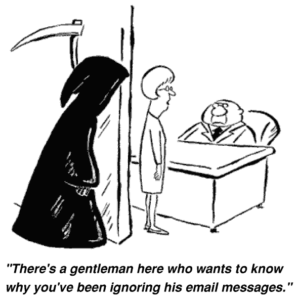According to a LinkedIn survey, only 15 percent of candidates are not even open to considering a new job. That means an overwhelming 85 percent ARE open to a new position, maybe via a recruitment email.
In such a scenario, if your email campaigns are not getting at least 45–50 percent conversions it is quite likely that you are doing it wrong.
If marketers and sales reps got the same conversion rate as recruiters, they would soon be out of a job.
My interactions with recruiters all over the globe tell me that most of them get a conversion of 15–20 percent. If your conversions are in this range, you are probably close to the median, but what could you do to put yourself miles ahead of the league?
Thank science for the fact that there is a lot of research that has gone behind our understanding of human brain. Using these simple principles of psychology and a bit of luck you can reach 40–45 percent conversions for your recruitment email outreach.
The purpose here is to enable you to have a framework to start thinking about your outreach. Although there are templates that worked for others, you have to find your own messaging and words that work the best for you and reflect who you and your employer brand are.
I like to divide “cold” recruitment emails in three parts: Subject line, Pitch and the ask.
Subject line
Try to evoke an emotional response. The job here is simple, although the most critical one — getting your recruitment email opened. You don’t get many words to do this.
On Gmail’s iPhone app, only the first 36 characters of a subject line are visible. So, in a limited real estate, your subject line should be able to trigger an emotion.
 There are two kind of emotional responses that you should aim to trigger.
There are two kind of emotional responses that you should aim to trigger.
1. Utility — Will your candidate think , “This looks like something that can be really useful in my career goals.” It gets the “What’s in it for me?” immediately out of the way. This kind of approach works really well for people who are extremely pressed for time and do not have discretionary power over allocating it. So if you are mailing a sales rep who spends most of his day calling and emailing prospective customers, a utilitarian approach might just work better.
2. Curiosity — If it can kill the cat, it can definitely get your email opened. Such a subject line works really well for those who have greater power over allocating their time to various activities. Imagine a great UX designer or a data scientist; they have a thousand things to do every day but they still have a great amount of power on allocating time to little distractions. A subject line that creates curiosity in reader’s mind can work really well for this demographic. Media companies like BuzzFeed perfected this to a science with their click bait. And it’s not just you — it’s hard for everyone to not fall prey to those clickbait titles and scroll through that content. If you can get your prospective candidate to think , “Ahh! That’s interesting. Let me check it out,” half the battle has already been won!
Pitch
Once your recruitment email is opened, you want to continue on a strong emotional trigger provided in the subject line. The first part of your email is the pitch. You probably don’t want to beat around the bush so much if you had used a utilitarian subject line.
This is the part where your job is a lot like the sales rep. You need to build credibility and trust for the candidate to say yes to your call to action in the mail. There are a couple of ways to do this.
3. Build trust: Fifty (50) years of cross disciplinary research has pointed out that trust is built by three factors — A) Knowledgeability; B) Familiarity; and C) Honesty. If you are reaching out to the candidate for the first time, going for familiarity is your best shot.
Seeing something familiar helps us build an instant trust. Mention your candidate’s current organization and role and they would immediately feel that this email was written specifically for them.
As a rule of thumb, mentioning at least two details that are very specific to the candidate increases conversions by at least 20–25 percent. Our social contract around recruitment email makes sure that in the recipient’s head you create a micro obligation to respond to the email.
4. Loss aversion and sure gains: Our brains are hardwired to be averse to loss (and to seek risky options to avert a sure loss) and be favorable to sure gains (and seek safer but sub optimal options to seek a sure gain). After you have built familiarity, it is your job to create a sure gain vs riskier option (to not replying) in your candidate’s head.
There are two ways to sway someone’s decision in your favor:
A- Loss Aversion: If you make (or do not make) this decision, you will surely stand to lose X.
B – Sure Gains: This choice will result in you gaining Y.
In case of a passive candidate, it’s really hard to push for loss aversion. The candidate is yet not invested enough to realize that not replying to you is a loss. It is going to take more than one touchpoint to start playing on loss aversion.
However, loss aversion is an extremely strong force. The best way to get to the loss aversion stage is to run a drip campaign that gets the candidates invested enough and then strike with loss aversion.
5 – Florida Effect/Priming effect: Our actions and biases get primed by the words we have been exposed to. To create this bias/priming, use candidate-centric language as much as you can. Use you, your, yours and minimize your use of I, we and ours. Help your candidate imagine herself or himself in your team and the split second decision that their brain will take on whether to respond or not will favor you!
The Ask
6 – Intuitive Heuristics: As complicated as it sounds, it’s a fairly straight forward concept. We don’t do well with hard questions that require conscious cognitive effort. However, it takes no time and effort to answer something out of intuition. In your first email, don’t ask candidate if they are interested in the position. There are hundreds of variables to consider and thus, you’re not likely to get a response. Instead, ask them to make a smaller investment. Are they open to a brief call? It’s much easier to say “yes” to a 15 minute call than evaluating whether this new role and company is interesting or not.
Persistence with your recruitment emails
No, this is not a psychological hack. It’s just a lesson learned by the best after years and years of successes and failures.
Remember — persistence always wins. Even the most beautifully crafted recruitment email is going to fail because of factors you can’t control, like the candidate who opened your email at the wrong time and missed replying to you.
When you have spent so much time and energy mailing a candidate once, go that extra mile and improve your conversions. All things being equal, the data we’ve collected show that multiple touch points have the highest effect in candidate conversions.
- Never give up at the first chance and always write a follow up to your original recruitment email.
- Create a drip campaign that will help your candidate get warmed up to the idea of working with your team.
- Also, we’ve also put together a bunch of templates for candidate outreach email that you can use and that have proven to be very effective.
In a candidate-centric world where great talent has hundreds of possibilities — in a verbal survey we conducted, we found that a developer gets an average of four (4) recruitment email messages a week! — your job is not to gather as many applicants as possible and hope that right ones find their way to the top.
As recruiters, our job is to understand the role and business needs, and then to hunt for the people we need.
It’s about time we learn from our colleagues in sales and marketing and understand human motivations and communication tactics in order to give our candidates the experience they truly deserve.
Authors
Manan Shah
Manan Shah is co-founder and CEO of Recruiterflow, recruitment CRM and ATS that helps businesses automate their candidate outreach and organize recruitment process. He previously worked as Head of Growth at Inshorts, India's highest rated news app with more than 2 million monthly active users. Follow Manan on Twitter @mananshah212, on Medium, or on Linkedin.
Recruit Smarter
Weekly news and industry insights delivered straight to your inbox.





